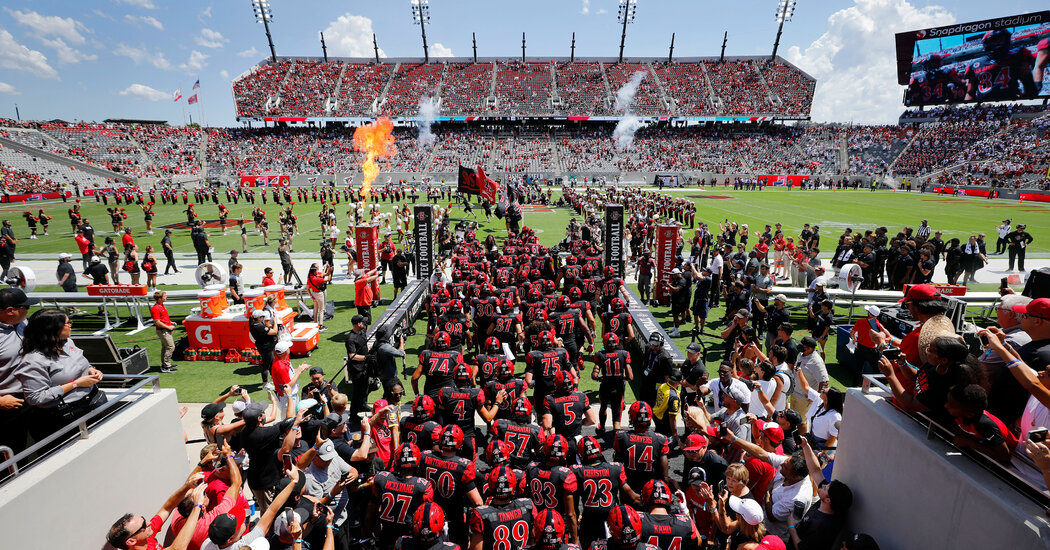[ad_1]
The latest turn of the conference realignment carousel driven by college football took me back to the Pleistocene period of journalism, when I worked as a summer news desk clerk amid the telex machines, pneumatic tubes and desk drawers full of booze at the dearly departed Los Angeles Herald Examiner.
A sign on an editor’s desk caught my eye: “Deadline is a two-syllable word.” Succinct and sly, it mocked one of the newsroom’s most sacrosanct tenets: Don’t blow deadline.
But in the digital era of continuous publishing, the notion of a deadline — which melds two of Merriam-Webster’s more unequivocal words — has somehow become malleable, a transformation that brings me back to the recent maneuverings of San Diego State University.
If the school was going to leave the Mountain West Conference for the Pac-12 in a year, it faced an 11 p.m. Pacific Time deadline on Friday to notify the Mountain West. Otherwise, its exit fee would double to about $36 million.
The problem: San Diego State did not have an offer from the Pac-12 Conference.
The reason: The Pac-12 did not have a media rights deal. (More on that in a moment.)
As the hourglass emptied on Friday, the Pac-12 chancellors and presidents convened to receive another one of their regular updates on the media rights negotiations. Later, San Diego State informed the Mountain West that it would stay put. For now.
That this unfolded on June 30 was fitting.
Last year on that date, Southern California and U.C.L.A., the Pac-12’s football and basketball standard-bearers, stunned the college athletics world by deciding to bolt for the Big Ten when the Pac-12’s television contract expires after the 2023-24 season.
This opened the door of opportunity for San Diego State, which has long pined for a move to the Pac-12 — a switch that would not only confer athletics legitimacy, but also put a California State University school on equal footing with Cal-Berkeley, a flagship school in the more prestigious University of California system.
It would require a three-step process. First, the Pac-12 would secure a media rights deal. Next, the 10 remaining members (the Pac-12 hoped) would sign a grant of rights, binding them to the conference for the duration of the media rights agreement. And finally, the conference would consider expansion.
Yet a year later, the Pac-12 is still in first gear.
The Pac-12, whose current agreement with ESPN and Fox expires after this season, found itself boxed out of several options when the Big 12 surprisingly locked in its media deal with Fox and ESPN last October, two months after the Big Ten announced its deal with Fox, CBS and NBC. The Southeastern Conference’s 10-year contract with ESPN kicks in next year, and the Atlantic Coast Conference’s deal with ESPN runs until 2036.
That leaves few openings on the broadcast schedule to showcase the Pac-12.
“The problem for the Pac-12 is all the other cards have now been dealt,” said Ed Desser, a sports media rights consultant, who noted that the only coveted spot would be Saturday night on ESPN or Friday night on ESPN, Fox, Apple or Amazon.
Negotiations have sputtered for several reasons.
First, the Pac-12 commissioner, George Kliavkoff, tried to persuade the University of California Board of Regents last fall to keep U.C.L.A. from leaving, which would have given the conference the valuable Los Angeles media market to shop around. (In December, the governing board voted not to block the move.)
Also last fall, many media companies began slashing jobs nearly across the board, particularly at Disney, which owns ESPN and said it would shed 7,000 jobs as it dealt with the continuing impact of cord cutting. And while streaming platforms like Apple and Amazon might be attractive, those companies are unlikely to view sports programming (that is not the N.F.L.) as indispensable.
It quickly became apparent that the media industry’s belt-tightening would manifest itself in second-tier rights deals. Shortly after the Big 12’s deal, which was largely considered below-market at $31.7 million per school, the Pac-12 adjusted downward by 10 percent estimates of an agreement it could reach if U.C.L.A. remained.
Then came the delays.
Expectations of an agreement by the start of the Pac-12 men’s basketball tournament led to hopes of a deal by the Final Four. And then by mid-April. And then surely by the start of summer. Now, the assumption is that an announcement will be made before the Pac-12’s football media day on July 21, so that the event’s dominant story line is actually football.
Of course, what is in the agreement will have consequences.
The Big 12, which added Brigham Young, Cincinnati, Central Florida and Houston on Saturday, and could lose Texas and Oklahoma this time next year, is interested in poaching any Pac-12 school that is unhappy enough to jump if the payout is significantly below what the Big 12 is receiving.
In that case, it would not take much — Colorado and Arizona leaving, perhaps, or Utah — for the Pac-12 to disintegrate.
These are the scenarios that San Diego State had to game out. The Aztecs, who came within one final push of winning a men’s basketball championship and who regularly exhibit a quietly competent football team, are in a familiar spot. They agreed in 2011 to jump to the Big East for football, while playing in the Big West for other sports. But two years later, that agreement collapsed and they remained in the Mountain West.
Last month, the San Diego State president, Adela de la Torre, wrote a letter to the Mountain West saying the school intended to leave and asking for more time. A flurry of back-and-forth letters ensued.
In the end, San Diego State determined that its conference exit may well be negotiable, as many before it have been. And so the school concluded that if a move to the Pac-12 were to happen, it would happen in time — deadlines be damned.
[ad_2]
Source link
